Born on the outskirts of Quito, Ecuadorian artist Miguel Betancourt grew up seeing clear blue sky, colorful vegetation and trees and the spirited people of the Andean mountains.
Over the next several decades, the powerful images imbued in his early consciousness would set him on a mission to distill the mystic beauty of Ecuador, a melting pot of antiquity and ecology at the northwestern edge of South America. From the untamed tropical jungle to timeworn colonial architecture, Betancourt has tapped his creative imagination to reinterpret his homeland’s vibrant colors, figures and rhythm.
The internationally acclaimed artist is famous for his fusion of Ecuadorian and European motifs and patterns. Born in 1958, he has lived an energetic, peripatetic life across the world, showcasing his works in the United States, Europe, Australia and China, among others.
Marking the 208th anniversary of Ecuador’s National Day, the First Call for Independence, some 50 of his paintings are on display at the Superior Gallery in Seoul through Aug. 31, organized by the Ecuadorian Embassy.
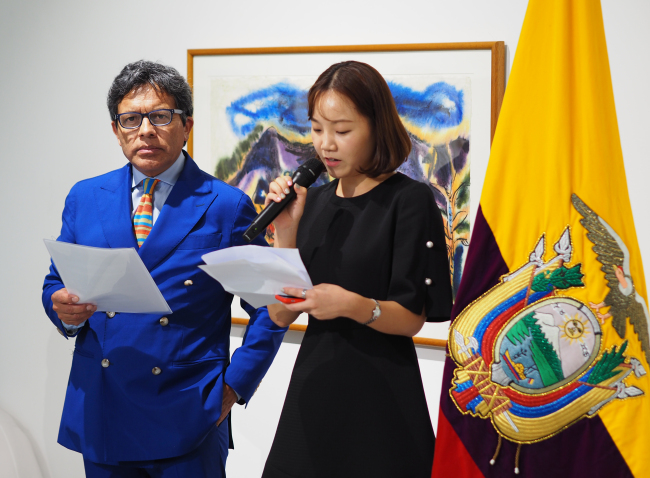
Ecuadorian artist Miguel Betancourt (left) speaks at the opening ceremony of exhibition “Ecuador Through My Dreams” at the Superior Gallery in Seoul on Thursday. (Joel Lee/The Korea Herald)
“I like to draw things related to my motherland, its environment, landscapes and architecture,” Betancourt told The Korea Herald at the opening ceremony of the exhibition “Ecuador Through My Dreams” on Thursday. “I am very eager to show to the world the ideas that have shaped us through the convergence of civilizations. Ecuador is an amalgam of diverse ethnicities, cultures and natural habits.”
Most Ecuadorians, including Betancourt, have mixed blood of indigenous and European origins, and are called “mestizos,” he pointed out.
Betancourt mostly works with acrylic, oil and watercolors on different textiles and papers these days. His paintings are vivaciously colorful and vigorous, with rough-hewn brushstrokes of indigo, yellow and red crisscrossing across the canvas. He has also used wood, tree branches, volcanic ashes and other earthly materials in his creations.
The colors come from primitive textiles spun by Ecuador’s ancient cultures, he said, mentioning pre-Columbian civilizations the Valdivia, Quitus, Caras and Canaris, which existed for millennia before the Incan Empire.
“We have very old and interesting indigenous cultures that existed thousands of years ago, with highly refined and exquisite art,” he explained. “They thrived along the Pacific coast, in the Amazon jungle and the Andean mountains and near present-day capital Quito. I am intensely interested in showing our distant past before the Spanish colonization.”
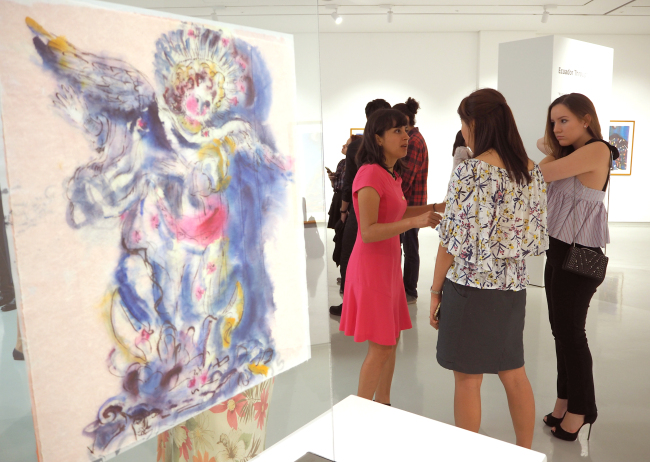
The exhibition “Ecuador Through My Dreams” runs at the Superior Gallery in Seoul through Aug. 31, featuring some 50 works of Ecuadorian artist Miguel Betancourt. (Joel Lee/The Korea Herald)
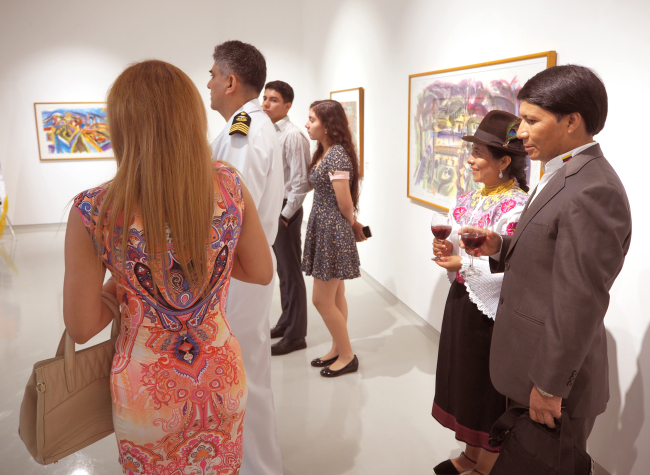
The exhibition “Ecuador Through My Dreams” runs at the Superior Gallery in Seoul through Aug. 31, featuring some 50 works of Ecuadorian artist Miguel Betancourt. (Joel Lee/The Korea Herald)
Noting that the outside world is largely unaware of Ecuador’s long forgotten past, he highlighted his efforts to express these native subjects and symbols in new ways, before promoting them on the world stage.
Betancourt studied at the Milwaukee Art Center in the US, Pontificia Universersidad Catolica del Ecuador, and Slade School of Fine Art at the University College London on a British Council scholarship. He was chosen to represent Ecuador at the 45th International Art Expo at the Venice Biennale in 1993, and received the Pollock-Krasner Award by the eponymous foundation in New York City in the same year.
The University of Western Sydney invited Betancourt to lecture on Ecuadorian art and exhibit his works at the Canberra Museum and Gallery in 2000. Two of his works are also part of the United Nations’ art collections in Vienna and Geneva.
Several of his paintings have been inspired by the “Virgin of Quito” -- a wooden sculpture by artist Bernardo de Legarda (ca. 1700-73) venerated at the altar of the Church and Convent of San Francisco in Quito -- a figure of popular veneration throughout the northern Andes region.
“I am not religious but respectful of our religions,” the painter highlighted, noting he takes key essences of national emblems and impregnates them with avant-garde identities. “Architecture and sculpture are other big sources of my inspiration. Ecuador has a wealth of Incan temples and Baroque-style colonial buildings, notable for their trapezoidal form and ornamental facades.”
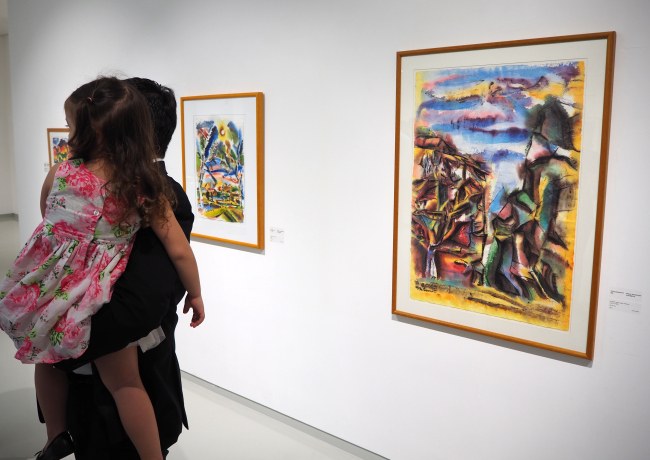
The exhibition “Ecuador Through My Dreams” runs at the Superior Gallery in Seoul through Aug. 31, featuring some 50 works of Ecuadorian artist Miguel Betancourt. (Joel Lee/The Korea Herald)
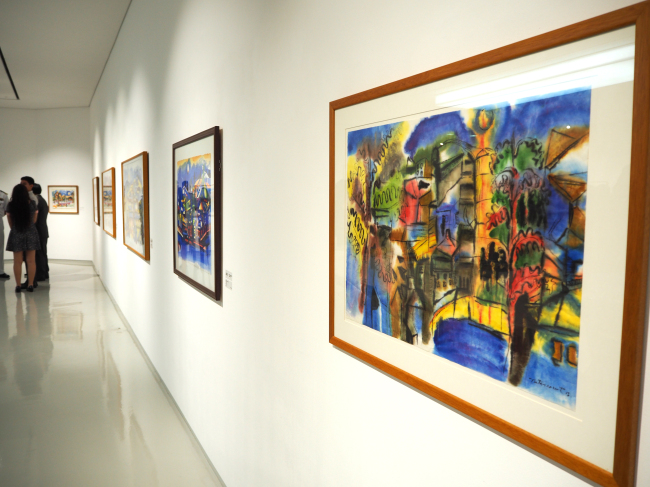
The exhibition “Ecuador Through My Dreams” runs at the Superior Gallery in Seoul through Aug. 31, featuring some 50 works of Ecuadorian artist Miguel Betancourt. (Joel Lee/The Korea Herald)
In the words of art critic Marta Traba, Ecuador participates in today’s world art scene through aesthetic pluralism and the fusion of techniques and methods, all part of the globalization of art. Betancourt belongs to this “eclectic generation” of Ecuadorian artists, and responds to these global artistic movements by delineating his own contours, she wrote in a journal, “Expressions of Experience: An insight into the vivid range of contemporary art in Ecuador.”
As in other parts of the world, being a financially successful artist is no easy, according to Betancourt.
“Artists cannot sit with their arms crossed and wait for people to come and see their works. We consciously have to promote ourselves,” he argued. “There are limits to what the government can do to promote art and culture. Just like businesses seeking opportunities around the world, I think artists should embrace globalization. Otherwise we become isolated.”
Regardless, artists’ chief reason being is to give a testimony of “who we are,” he asserted. “I believe that an artist must begin at his roots to arrive at the universal. My Ecuadorian essence is founded in the confrontation of different cultures. I try to lift up my art by assimilating these aspects and expressing my native experiences.”
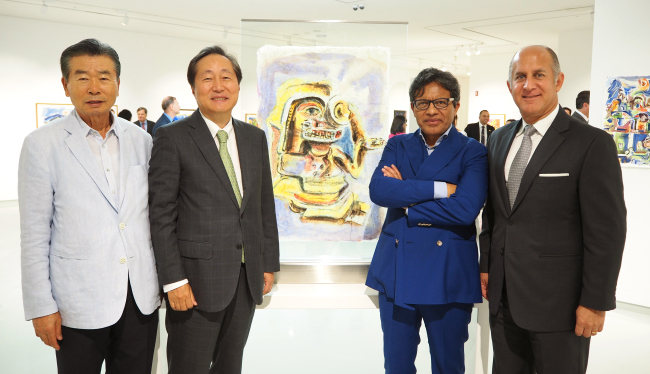
(From left) Superior Group President Kim Gui-yeol, Dongwon Industries Co. CEO Lee Myung-woo, Ecuadorian artist Miguel Betancourt and Ecuadorian Ambassador to Korea Oscar Herrera Gilbert at the exhibition “Ecuador Through My Dreams” at the Superior Gallery in Seoul (Joel Lee/The Korea Herald)
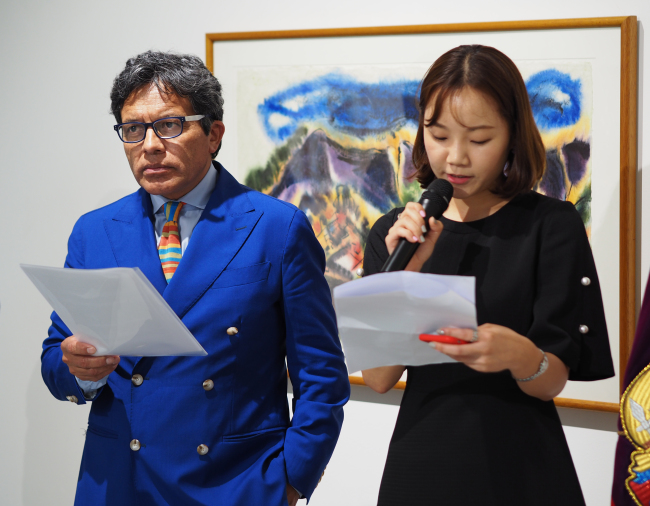
Ecuadorian artist Miguel Betancourt (left) speaks at the opening ceremony of exhibition “Ecuador Through My Dreams” at the Superior Gallery in Seoul on Thursday. (Joel Lee/The Korea Herald)
Betancourt elucidated on Ecuador’s domestic situation, saying the country is in the midst of opening itself economically and diversifying its revenues from the petroleum-oriented development strategy.
“Ecuador is trying hard to promote its tourism. We offer diverse natural attractions, ranging from the Amazon forests and the Andes Mountains to spectacular coasts along the Pacific as well as the enchanting Galapagos Islands,” he said.
“I believe opportunities for international cooperation will grow in the future in diverse areas, starting with tourism.”
By Joel Lee (joel@heraldcorp.com)












![[KH Explains] Hyundai's full hybrid edge to pay off amid slow transition to pure EVs](http://res.heraldm.com/phpwas/restmb_idxmake.php?idx=645&simg=/content/image/2024/04/18/20240418050645_0.jpg&u=20240419100350)